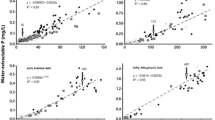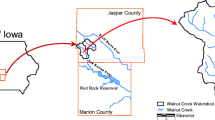Abstract
Bioavailable phosphorus (BAP) transported in agricultural runoff can accelerate surface water eutrophication. Although several algal assays and chemical extractions have been proposed to estimate BAP, procedural and theoretical limitations have restricted widespread BAP measurement. Thus, a routine method was developed to estimate BAP, which uses iron oxide-impregnated paper strips (Fe-oxide strips) as a P-sink for BAP in runoff. In the proposed method BAP is determined by shaking 50 mL of unfiltered runoff with one Fe-oxide strip for 16 h. Phosphorus is removed from the strip by 0.1M H2SO4 and measured. The BAP content of runoff from 20 agricultural watersheds in the Southern Plains was related to the growth of P-starved algae incubated for 29 d with runoff as the sole source of P. Acting as a P sink, Fe-oxide strips may have a stronger theoretical basis than chemical extraction in estimating BAP. The method may also have potential use as an environmental soil P test to indicate soils liable to enrich runoff with sufficient P to accelerate eutrophication. Bioavailable P loss in runoff was lower from no till (438 g ha−1 yr−1) than from conventional till (1288 g ha−1 yr−1). Kinetic and enrichment ratio approaches accurately predicted (r2 of 0.93) BAP transport in runoff during 1988 to 1990. Use of the Fe-oxide strip method will facilitate estimation of BAP transport in runoff and thereby, improve assessment of the resultant impact on the biological productivity of receiving surface waters.
Similar content being viewed by others
Abbreviations
- A:
-
Degree of soil aggregation (unitless)
- B:
-
Soil bulk density (Mg m−3)
- BAP:
-
Bioavailable P content of runoff (mg L−1 and kg ha−1)
- BIOP:
-
Bioavailable P content of soil (mg kg−1)
- BPP:
-
Bioavailable particulate P content of runoff (mg L−1 and kg ha−1)
- D:
-
Effective depth of interaction between runoff and surface soil (mm)
- DP:
-
Dissolved P content of runoff (mg L−1 and kg ha−1)
- ER:
-
Enrichment ratio (unitless)
- P:
-
Phosphorus
- Pa :
-
Bray I available P content of 0-50 mm depth of soil (mg kg−1)
- PP:
-
Particulate P content of runoff (mg L−1 and kg ha−1)
- STP:
-
Soil test P, plant available (mg kg−1)
- TP:
-
Total P content of runoff (mg L−1 and kg ha−1)
- t:
-
Duration of runoff event (min)
- W:
-
Runoff water/soil (suspended sediment) ratio (L g−1)
- K,α, ß, i:
-
Constants of the equation describing the kinetics of soil P desorption
References
Allison LE and Moodie CD (1965) Carbonate. In: Black CAet al. (eds) Methods of soil analysis, Part 2. Agronomy 9: 1379–1394
Bray RH and Kurtz LT (1945) Determination of total, organic and available forms of phosphorus in soils. Soil Sci 59: 39–45
Day PR (1965) Particle fractionation and particle size analysis. In: Black CAet al. (eds) Methods of soil analysis, Part 1, Agronomy 9: 545–567
Fixen PE and Grove JM (1990) Testing soils for phosphorus. In: Westerman RL (ed) Soil testing and plant analysis, 3rd ed., SSSA Book Series, No. 3, pp 141–180. Soil Sci Soc Am, Madison, WI
Hegemann DA, Johnson AH and Keenan JD (1983) Determination of algae-available phosphorus on soil and sediment: A review and analysis. J Environ Qual 12: 12–16
Hope GD and Syers JK (1976) Effects of solution: soil ratio on phosphate sorption by soils. J Soil Sci 27: 301–306
Krogstad T and Lovstad O (1989) Erosion, phosphorus and phytoplankton response in rivers of South-Eastern Norway. Hydrobiologia 183: 33–41
Levine SL and Schindler DW (1989) Phosphorus nitrogen and carbon dynamics of experimental lake 303 during recovery from eutrophication. Can J Fish Aquat Sci 46: 2–10
Laflen JM and Tabatabai MA (1984) Nitrogen and phosphorus losses from corn-soybean rotations as affected by tillage practices. Trans Am Soc Agric Eng 27: 58–63
Langdale GW, Leonard RA and Thomas AW (1985) Conservation practice effects on phosphorus losses from Southern Piedmont watersheds. J Soil Water Conserv 40: 157–160
Lin TH, Ho SB and Houng KH (1991) The use of iron oxide-impregnated filter paper for the extraction of available phosphorus from Taiwan soils. Plant Soil 133:219–226
McLean EO (1965) Aluminum. In: Black CAet al. (eds) Methods of soil analysis, Part 2, Agronomy 9: 978–998
Mehlich A (1984) Mehlich 3 soil test extractant: A modification of Mehlich 2 extractant. Commun. Soil Sci Plant Anal 15: 1409–1416
Menon RG (1993) The Pi tests for evaluating bioavailability of phosphorus. In: Hoddinott K and O'Shay TC (eds) Application of agricultural analysis in environmental studies, pp 58–67. Am Soc Testing and Materials, Philadelphia, PA
Menon RG, Hammond LL and Sissingh HA (1989a) Determination of plant available phosphorus by the iron hydroxide-impregnated filter paper (Pi) soil test. Soil Sci Soc Am J 53: 110–115
Menon RG, Chien SH, Hammond LL and Arora BR (1990) Sorption of phosphorus by the iron oxide-impregnated filter paper (Pi soil test) embedded in soil. Plant Soil 126: 287–294
Menon RG, Chien SH, Hammond LL and Henoa J (1989b) Modified techniques for preparing paper strips for the new Pi soil test for phosphorus. Fert Res 19: 85–91
Miller WE, Greene JC and Shiroyarna T (1978) TheSelenastrum capricornutum Printz algal assay bottle test and data interpretation protocol. U.S. EPA, Tech Rep EPA-600/9-78-018
Murphy J and Riley JP (1962) A modified single solution method for the determination of phosphate in natural waters. Anal Chim Acta 27: 31–36
Olsen SR and Sommers LE (1982) Phosphorus. In: Page ALet al. (eds) Methods of soil analysis, Part 2, 2nd ed., Agronomy 9: 403–429
Olsen SR, Cole CV, Watanabe FS and Dean LA (1954) Estimation of available phosphorus in soils by extraction with sodium bicarbonate, U.S. Dept Agric Circ. 939
Olson RV (1965) Iron. In: Black CAet al. (eds) Methods of soil anlaysis, Part 2, Agronomy 9: 963–973
PAPP (1969) Provisional algal assay procedure. Joint Ind. Gov. Task Force on Eutrophication. USDI, Corvallis, OR
Pesant AR, Dionne JL and Genest J (1987) Soil and nutrient losses in surface runoff from conventional and no-till corn systems. Can J Soil Sci 67: 835–843
Peters RH (1981) Phosphorus availability in Lake Memphremagog and its tributaries. Limnol Oceanogr 26: 1150–1161
Raveh A and Avnimelech Y (1972) Potentiometric determination of soil organic matter. Soil Sci Soc Am Proc 36: 397
Schreiber JD (1990) Estimating soluble phosphorus from green crops and their residues in agricultural runoff. In: DeCoursey DG (ed) Small watershed model (SWAM) for water, sediment and chemical movement: Supporting documentation, pp 77-95. U.S. Dept Agric Agric Res Ser, ARS-80
Sharpley AN (1983) Effect of soil properties on the kinetics of phosphorus desorption. Soil Sci Soc Am J 47: 462–467
Sharpley AN (1985a) Depth of surface soil-runoff interaction as affected by rainfall, soil slope and management. Soil Sci Soc Am J 49: 1010–1015
Sharpley AN (1985b) The selective erosion of plant nutrients in runoff. Soil Sci Soc Am J 49: 1527–1534
Sharpley AN (1991) Soil phosphorus extracted by ironaluminium-oxide-impregnated filter paper. Soil Sci Soc Am J 55: 1038–1041
Sharpley AN (1993) An innovative approach to estimate bioavailable orthophosphate in agricultural runoff using iron oxide-impregnated paper. J Environ Qual 22: 597–601.
Sharpley AN and Smith SJ (1989) Prediction of soluble phosphorus transport in agricultural runoff. J Environ Qual 18: 313–316
Sharpley AN, Troger WW and Smith SJ (1991) The measurement of bioavailable phosphorus in agricultural runoff. J Environ Qual 20: 235–238
Sharpley AN, Ahuja LR, Yamamoto M and Menzel RG (1981a) The kinetics of phosphorus desorption from soil. Soil Sci Soc Am J 45: 493–496
Sharpley AN, Jones CA, Gray C and Cole CV (1984) A simplified soil and plant phosphorus model: II Prediction of labile organic and sorbed phosphorus. Soil Sci Soc Am J 48: 805–809
Sharpley AN, Menzel RG, Smith SJ, Rhoades ED and Olness AE (1981b) The sorption of soluble phosphorus by soil material during transport in runoff from cropped and grassed watersheds. J Environ Qual 10: 211–215
Sharpley AN, Smith SJ, Jones OR, Berg WA and Coleman GA (1992) The transport of bioavailable phosphorus in agricultural runoff. J Environ Qual 21: 30–35
Sibbesen E (1983) Phosphate soil tests and their suitability to assess the phosphate status of soil. J Sci Food Agric 34: 1368–1374
Sims JT (1992) Environmental management of phosphorus in agricultural and municipal wastes. In: Sikora FJ (ed) Future directions for agricultural phosphorus research, pp 59–64. Nat Fert Environ Res Cent, TVA, Muscle Shoals, AL
Soil Conservation Service (1984) Procedures for collecting soil sample and methods of analysis for soil survey. USDA, Soil Survey Investigations Rep. No. 1
Syers JK, Harris RF and Armstrong DE (1973) Phosphate chemistry in lake sediments. J Environ Qual 2: 1–14
Troeger WW (1978) Survey of algae in farm ponds in Bryan County, Oklahoma. Southwestern Nat 23: 51–62
Wolf AM, Baker DE, Pionke HB and Kunishi HM (1985) Soil test for estimating labile, soluble, and algaeavailable phosphorus in agricultural soils. J Environ Qual 14: 341–348
Author information
Authors and Affiliations
Rights and permissions
About this article
Cite this article
Sharpley, A.N. Assessing phosphorus bioavailability in agricultural soils and runoff. Fertilizer Research 36, 259–272 (1993). https://doi.org/10.1007/BF00748704
Received:
Accepted:
Issue Date:
DOI: https://doi.org/10.1007/BF00748704




